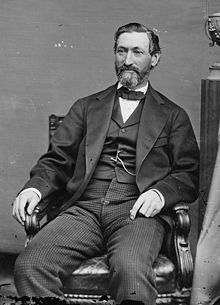William H. Barnum
| William Henry Barnum | |
|---|---|
 |
|
|
United States Senator from Connecticut |
|
|
In office May 18, 1876 – March 4, 1879 |
|
| Preceded by | James E. English |
| Succeeded by | Orville H. Platt |
| Member of the U.S. House of Representatives from Connecticut's 4th district |
|
|
In office March 4, 1867 – May 18, 1876 |
|
| Preceded by | John Henry Hubbard |
| Succeeded by | Levi Warner |
| Member of the Connecticut House of Representatives | |
|
In office 1851–1852 |
|
| Personal details | |
| Born |
September 17, 1818 Boston Corners, Massachusetts |
| Died | April 30, 1889 (aged 70) Lime Rock, Connecticut |
| Political party | Democratic |
| Religion | Episcopalian |
William Henry Barnum (September 17, 1818 – April 30, 1889) was an American politician, serving as a state representative, U.S. Representative, U.S. Senator, and finally as chairman of the Democratic National Committee. He was also known as Seven Mule Barnum.
Though born in Berkshire County, Massachusetts, Barnum moved to Lime Rock, Connecticut and served in the state house of representatives from 1851 to 1852. He then served in the United States House of Representatives for Connecticut's 4th District from March 4, 1867 until his resignation on May 18, 1876, Barnum then became a United States Senator, serving until March 4, 1879. He was chairman of the DNC from 1877 to 1889. He died in Lime Rock on April 30, 1889 and is buried in Lime Rock Cemetery.
In addition to Barnum's political attainments — which also include defeating his third cousin, the famous showman P. T. Barnum, for Congress, and notably being the longest-serving chair of the Democratic National Committee — Barnum was a prominent industrialist. The Barnum Richardson Company, of which he was chief executive, was headquartered in Lime Rock (now a neighborhood of Lakeville) CT, was the leading company in the Salisbury iron district of that time, owning or controlling iron mines, charcoal production resources, limestone quarries, and rail transportation. Barnum Richardson Company was also the preeminent manufacturer of railroad car wheels at a time when the railroad industry held a place in the economy analogous to the computer industry today.
In 1872 he partnered with Collis P. Huntington to finance Ensign Manufacturing Company, a railroad freight car manufacturer. Among Ensign's products were the largest wooden hopper cars built for Central Pacific Railroad as well as a large number of high-capacity wood boxcars for Southern Pacific Railroad (both railroads were controlled in part by Huntington). Ensign was one of the 13 companies that merged in 1899 to form American Car and Foundry Company.
...
Wikipedia
